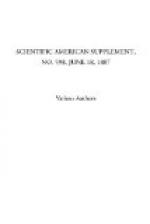One of the most interesting and valuable features in the development of naval construction in recent years is the great advance which has been made in the speeds of our war ships. This advance has been general, and not confined to any particular vessel or class of vessel. From the first class armored fighting ship of about 10,000 tons displacement down to the comparatively diminutive cruiser of 1,500 tons, the very desirable quality of a high speed has been provided.
These are all twin screw ships, and each of the twins is driven by its own set of engines and line of shafting, so that the propelling machinery of each ship is duplicated throughout. The speeds attained indicate a high efficiency with the twin screws. In all ships, but more especially in high speed ships, success depends largely upon the provision of propellers suited for the work they have to perform, and where a high propulsive efficiency has been secured, there is no doubt the screws are working with a high efficiency. The principal purpose of this paper is to record the particulars of the propellers, and the results of the trials of several of these high speed twin screw ships. The table gives the leading particulars of several classes of ships, the particulars of the screws, and the results obtained on the measured mile trials from a ship of each class, except C. The vessels whose trials are inserted in the table have not been selected as showing the highest speeds for the several classes. Excepting C, they are the ships which have been run on the measured mile at or near the designed load water line. On light draught trials, speeds have been attained from half a knot to a knot higher than those here recorded. No ship of the class C has yet been officially tried on the measured mile, but as several are in a forward state, perhaps the actual data from one of them may shortly be obtained. All these measured mile trials were made under the usual Admiralty conditions, that is to say, the ships’ bottoms and the screws were clean, and the force of the wind and state of the sea were not such as to make the trials useless for purposes of comparison. On such trials the i.h.p. is obtained from diagrams taken while the ship is on the mile, and the revolutions are recorded by ruechanical counters for the time occupied in running the mile. Not less than four runs are made during a trial extending over several hours. The i.h.p. in the table is not necessarily the maximum during the trial, for the average while on the mile is sometimes a little below the average for the whole of the trial. The revolutions are the mean for the two sets of engines, and the i.h.p. is the sum of the powers of the two sets. The pitch of the screw is measured. The bolt holes in the blade flanges allow an adjustment of pitch, but in each case the blades were set as nearly as possible at the pitch at which they were cast. The particulars given in the table may be taken to be as reliable and accurate as such things can be




